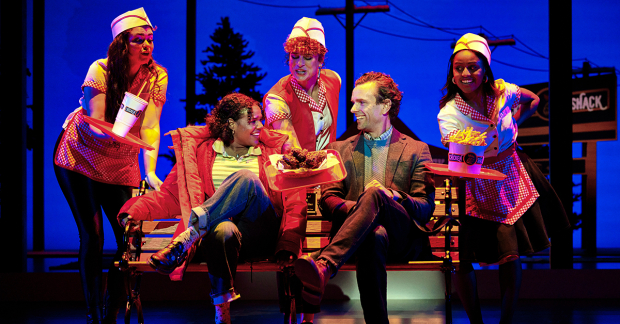Review: Life After Plumbs the Depths of a Teen's Grief After a Parent's Death

(© Jeremy Daniel)
Several very successful musicals in the last decade have featured adolescents dealing with death in one way or another. Fun Home and Dear Evan Hansen readily come to mind, and now are joined by Life After in that particular (and perhaps peculiar) subset of shows. Life After, now running at the Goodman Theatre, has not yet been seen in New York, but this new production could make the jump, featuring a nearly all-Big Apple cast and company in a Broadway-size staging.
Teenaged Alice Carter (Samantha Williams) is consumed with grief and guilt when her father, Frank (Paul Alexander Nolan), dies in a car accident on a snowy road, miles from where he should have been. A successful author and self-help guru, Frank had missed his flight to an important conference, and Alice believes he was looking for her, in part because they had argued that morning, the day of her 16th birthday. Alice's support group includes her strong mother Beth (Bryonha Marie Parham), her sister Kate (Skyler Volpe), her friend Hannah (Lucy Panush), and a sympathetic teacher (Jen Sese). There also is a small Greek chorus of three Furies (Ashley Perez Flanagan, Lauryn Hobbs, and Chelsea Williams), who play mourners, partiers, autograph-seekers, etc. Presented in a tongue-in-cheek way, the Furies can be smooth or waspish, but they always are stylish.
Grief and survivor's guilt are profound issues, but they are not unique to this show. Nonetheless, this leanly written, laser-focused show has a fresh, crisp feel and sound due to the intelligence of the book, music, and lyrics all by Canadian writer Britta Johnson. She director Annie Tippe, and a top company keep Life After on a swift and compelling path as Alice fights to understand herself and her circumstances, while taking steps toward adulthood in the process.
The show's tightly unified structure is impressive, squeezing 18 numbers into 95 minutes. The show isn't through-scored but kinda-sorta feels as if it is because songs are served up without introductions and end without buttons. Dance and movement (Ann Yee, choreography) also segue smoothly to whatever-is-next without hitting final poses. Music and dance seem to melt into, and then out of, the whole. Audience applause never breaks the performance and — for once — it feels absolutely right.

(© Jeremy Daniel)
Johnson's jazz-inflected music features lots of close harmony — especially for the three Furies — a string bass and some Latin rhythms. The score also sports Sondheim influences (as Johnson acknowledges) and some classical chops as well. Chris Kong is the musical director, with arrangements and orchestrations by Lynne Shankel for string quartet, harp, percussion and keyboard. It sounds great, with no regrets for the missing brass. A few more strings and some woodwinds would make it better. (Maybe in New York?) Joanna Lynne Staub's sound design is a big plus, achieving perfect balance and clarity throughout the house.
For all its variety, vivacity and effectiveness, the score doesn't offer many hummable tunes, and most of its big numbers come up later in the show, beginning with "Forgive Yourself," a production number featuring the entire cast (save one). Presented as a flashback, it features Frank at one of his self-help presentations he calls "Transformotion" (emblazoned in neon across the stage), not coincidentally a name Alice thought up. Life After closes with three powerful numbers, Beth's moving-on song, "Wallpaper," a flashback duet for Alice and Frank, "Snow," and Alice's soaring finish, "Poetry."
The scenic design by Todd Rosenthal is wonderful; a huge white cut-out of a three-story house, the frame of which provides a shadowbox feel. Rosenthal then doubles the effect with a see-through rear house wall, creating a second upstage shadowbox through which other scenic pictures are displayed as needed. Lighting designer Yi Zhao — clearly in close collaboration with Rosenthal — has provided extremely bold lighting which makes use of wide swaths of saturated colors: blue, purple, orange, green and large neon lights, too. The total scenic-and-lighting effect is neither pop art nor comic strip, but it has some flavor of each. It's fun and works surprisingly well in a show with subject matter some might consider a downer. Costumes by Sarafina Bush provide fancy, showy glad-rags for the Furies but otherwise are contemporary casual wear: jeans for Alice, tieless shirt and jacket for Frank, comfortable house clothing for Beth, and so on.
Judging by this vibrant production, Life After definitely should have an after-life when this Goodman runs ends.










